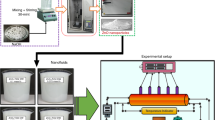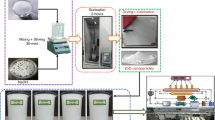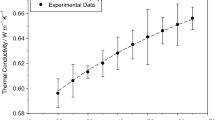Abstract
The thermophysical properties of ZnO@TiO2/DW composite nanofluids with (0.1, 0.075, 0.05 and 0.025)mass% concentrations have been experimentally studied. The equal and homogenous dispersion of both ZnO and TiO2 nanoparticles with 50:50 ratio each in distilled water (DW) was attained by the sonochemical method. The efforts are directed to examine the effective thermal conductivity of the different mass% concentrations of ZnO@TiO2/DW composite nanofluid for a selected range of temperatures at 20 to 45 °C. The maximum improvement in thermal conductivity for ZnO@TiO2/DW composite nanofluid was noticed for 0.1 mass% concentration, and the maximum enhancement was spotted 47% higher than the base fluid (DW). The heat transfer properties of ZnO@TiO2/DW composite nanofluids with (0.1, 0.075, 0.05 and 0.025) mass% concentrations and base fluid (DW) in a square heat exchanger were also investigated. Average and local heat transfer values and growth in Nusselt values were conquered for different velocities and corresponding to specific Reynolds numbers range from 4550 to 20,360. The maximum improvement increases about 57% in average heat transfer (h) and Nusselt numbers correspondingly, while local heat transfer for 0.1 mass% is about 500 to 1750 W m−2 K, for 0.075 mass% is 500 to 1500 W m−2 K, for 0.05 mass% is 500 to 1370 and for 0.025 mass% is 500 to 1150 of the composite nanofluid which is greater than base fluid (DW). The ZnO and TiO2 mixture gives the best combination to enhance the overall heat transfer coefficient (h).
Graphic abstract















Similar content being viewed by others
References
Agarwal DK, Vaidyanathan A, Sunil Kumar S. Investigation on convective heat transfer behaviour of kerosene-Al2O3 nanofluid. Appl Therm Eng. 2015;84:64–73.
Alyan A, Abdel-Samad S, Massoud A, Waly SA. Characterization and thermal conductivity investigation of Copper-Polyaniline Nano composite synthesized by gamma radiolysis method. Heat Mass Transf. 2019;55(9):1–9.
Arote SA, Pathan AS, Hase YV, Bardapurkar PP, Gapale DL, Palve BM. Investigations on synthesis, characterization and humidity sensing properties of ZnO and ZnO–ZrO2 composite nanoparticles prepared by ultrasonic assisted wet chemical method. Ultrason Sonochem. 2019;55:313–21.
Azwadi CSN, Adamu IM, Jamil MM. Preparation methods and thermal performance of hybrid nanofluids. J Adv Rev Sci Res. 2016;24(1):13–23.
Bahiraei M, Mazaheri N, Rizehvandi A. Application of a hybrid nanofluid containing graphene nanoplatelet–platinum composite powder in a triple-tube heat exchanger equipped with inserted ribs. Appl Therm Eng. 2019;149:588–601.
Blasius H. Grenzschichten in Flüssigkeiten mit kleiner Reibung. Leipzig: Druck von BG Teubner; 1907.
Botha SS, Ndungu P, Bladergroen BJ. Physicochemical properties of oil-based nanofluids containing hybrid structures of silver nanoparticles supported on silica. Ind Eng Chem Res. 2011;50(6):3071–7.
Choi SUS. Developments and applications of non-Newtonian flows. New York: ASME; 1995. p. 99.
Choi SUS, Eastman JA. Enhancing thermal conductivity of fluids with nanoparticles. Lemont: Argonne National Lab; 1995.
Dhinesh Kumar D, Valan Arasu A. A comprehensive review of preparation, characterization, properties and stability of hybrid nanofluids. Renew Sustain Energy Rev. 2018;81:1669–89.
Esfe MH, Raki HR, Emami MRS, Afrand M. Viscosity and rheological properties of antifreeze based nanofluid containing hybrid nano-powders of MWCNTs and TiO2 under different temperature conditions. Powder Technol. 2019;342:808–16.
Fernandez-Seara J, Uhía FJ, Sieres J, Campo A. A general review of the Wilson plot method and its modifications to determine convection coefficients in heat exchange devices. Appl Therm Eng. 2007;27(17–18):2745–57.
Godson L, Raja B, Lal DM, Wongwises S. Enhancement of heat transfer using nanofluids—an overview. Renew Sustain Energy Rev. 2010;14(2):629–41.
Hamid KA, Azmi WH, Nabil MF, Mamat R, Sharma KV. Experimental investigation of thermal conductivity and dynamic viscosity on nanoparticle mixture ratios of TiO2–SiO2 nanofluids. Int J Heat Mass Transf. 2018;116:1143–52.
Hammed NA, Aziz AA, Usman AI, Qaeed MA. The sonochemical synthesis of vertically aligned ZnO nanorods and their UV photodetection properties: effect of ZnO buffer layer. Ultrason Sonochem. 2019;50:172–81.
Huminic G, Huminic A. Hybrid nanofluids for heat transfer applications—a state-of-the-art review. Int J Heat Mass Transf. 2018;125:82–103.
Jamali M, Toghraie D. Investigation of heat transfer characteristics in the developing and the developed flow of nanofluid inside a tube with different entrances in the transition regime. J Therm Anal Calorim. 2019;139:1–15.
Javadzadegan A, Motaharpour SH, Moshfegh A, Akbari OA, Afrouzi HH, Toghraie D. Lattice-Boltzmann method for analysis of combined forced convection and radiation heat transfer in a channel with sinusoidal distribution on walls. Phys A Stat Mech Appl. 2019;526:121066.
Kumar N, Sonawane SS. Experimental study of Fe2O3/water and Fe2O3/ethylene glycol nanofluid heat transfer enhancement in a shell and tube heat exchanger. Int Commun Heat Mass Transf. 2016;78:277–84.
Kumar V, Sarkar J. Research and development on composite nanofluids as next-generation heat transfer medium. J Therm Anal Calorim. 2019;137(4):1133–54.
Li Z, Barnoon P, Toghraie D, Dehkordi RB, Afrand M. Mixed convection of non-Newtonian nanofluid in an H-shaped cavity with cooler and heater cylinders filled by a porous material: two phase approach. Adv Powder Technol. 2019;30(11):2666–85.
Masuda H, Ebata A, Teramae K, Hishinuma N, Ebata Y. Alteration of thermal conductivity and viscosity of liquid by dispersing ultra-fine particles. Dispersion of γ-Al2O3, SiO2 and TiO2 ultra-fine particles. 1993.
Mostafazadeh A, Toghraie D, Mashayekhi R, Akbari OA. Effect of radiation on laminar natural convection of nanofluid in a vertical channel with single-and two-phase approaches. J Therm Anal Calorim. 2019;138(1):779–94.
Nazari MA, Ghasempour R, Ahmadi MH, Heydarian G, Shafii MB. Experimental investigation of graphene oxide nanofluid on heat transfer enhancement of pulsating heat pipe. Int Commun Heat Mass Transf. 2018;91:90–4.
Nguyen CT, Roy G, Gauthier C, Galanis N. Heat transfer enhancement using Al2O3-water nanofluid for an electronic liquid cooling system. Appl Therm Eng. 2007;27(8–9):1501–6.
Ouikhalfan M, Labihi A, Belaqziz M, Chehouani H, Benhamou B, Sari A, Belfrika A. Stability and thermal conductivity enhancement of aqueous nanofluid based on surfactant-modified TiO2. J Dispers Sci Technol. 2019. https://doi.org/10.1080/01932691.2019.1578665.
Palacios A, Cong L, Navarro ME, Ding Y, Barreneche C. Thermal conductivity measurement techniques for characterizing thermal energy storage materials—a review. Renew Sustain Energy Rev. 2019;108:32–52.
Parrales A, Hernández-Pérez JA, Flores O, Hernandez H, Gómez-Aguilar JF, Escobar-Jiménez R, Huicochea A. Heat Transfer coefficients analysis in a helical double-pipe evaporator: Nusselt number correlations through artificial neural networks. Entropy. 2019;21(7):689.
Petukhov BS. Heat transfer and friction in turbulent pipe flow with variable physical properties, Advances in heat transfer. Adv Heat Transf. 1970;6:503–64.
Peyghambarzadeh SM, Hashemabadi SH, Hoseini SM, Jamnani MS. Experimental study of heat transfer enhancement using water/ethylene glycol based nanofluids as a new coolant for car radiators. Int Commun Heat Mass Transf. 2011;38(9):1283–90.
Phillips SH, Haddad TS, Tomczak, SJ. Developments in nanoscience: polyhedral oligomeric silsesquioxane (POSS)-polymers. Curr Opin Solid State Mater Sci. 2004;8(1):21–9.
Ramadhan AI, Azmi WH, Mamat R, Hamid KA, Norsakinah S. Investigation on stability of tri-hybrid nanofluids in water-ethylene glycol mixture. In: IOP Conference Series: Materials Science and Engineering. 2019. 1st International Postgraduate Conference on Mechanical Engineering (IPCME2018), 31 October 2018 , UMP Library, Pekan. pp. 1–9.
Ricard D, Roussignol P, Flytzanis C. Surface-mediated enhancement of optical phase conjugation in metal colloids. Opt Lett. 1985;10(10):511–3.
Said Z, Sabiha MA, Saidur R, Hepbasli A, Rahim NA, Mekhilef S, Ward TA. Performance enhancement of a flat plate solar collector using titanium dioxide nanofluid and polyethylene glycol dispersant. J Clean Prod. 2015;92:343–53.
Saleh R, Putra N, Wibowo RE, Septiadi WN, Prakoso SP. Titanium dioxide nanofluids for heat transfer applications. Exp Therm Fluid Sci. 2014;52:19–29.
Saranprabhu MK, Rajan KS. Magnesium oxide nanoparticles dispersed solar salt with improved solid phase thermal conductivity and specific heat for latent heat thermal energy storage. Renew Energy. 2019;141:451–9.
Sebastian N, Yu WC, Hu YC, Balram D, Yu YH. Sonochemical synthesis of iron-graphene oxide/honeycomb-like ZnO ternary nanohybrids for sensitive electrochemical detection of antipsychotic drug chlorpromazine. Ultrason Sonochem. 2019;59:104696.
Selvakumar RD, Dhinakaran S. Nanofluid flow and heat transfer around a circular cylinder: a study on effects of uncertainties in effective properties. J Mol Liq. 2016;223:572–88.
Shah J, Ranjan M, Sooraj KP, Sonvane Y, Gupta SK. Surfactant prevented growth and enhanced thermophysical properties of CuO nanofluid. J Mol Liq. 2019;283:550–7.
Shahidi S, Rezaee H, Rashidi A, Ghoranneviss M. In situ synthesis of ZnO Nanoparticles on plasma treated cotton fabric utilizing durable antibacterial activity. J Nat Fibers. 2018;15(5):639–47.
Sivasamy P, Harikrishnan S, Jayavel R, Hussain SI, Kalaiselvam S, Lu L. Preparation and thermal characteristics of caprylic acid based composite as phase change material for thermal energy storage. Mater Res Express. 2019;6(10):105051.
Sobhan CB, Peterson GP. Microscale and nanoscale heat transfer: fundamentals and engineering applications. Boca Raton: CRC Press; 2008.
Sundar LS, Sharma KV, Singh MK, Sousa ACM. Hybrid nanofluids preparation, thermal properties, heat transfer and friction factor—a review. Renew Sustain Energy Rev. 2017;68:185–98.
Taha-Tijerina J, Narayanan TN, Gao G, Rohde M, Tsentalovich DA, Pasquali M, Ajayan PM. Electrically insulating thermal nano-oils using 2D fillers. ACS Nano. 2012;6(2):1214–20.
Taherian H, Alvarado JL, Mohseni Languri E. Enhanced thermophysical properties of multiwalled carbon nanotubes based nanofluids. Part 1: critical review. Renew Sustain Energy Rev. 2018;82:4326–36.
Uysal C, Gedik E, Chamkha A. A numerical analysis of laminar forced convection and entropy generation of a diamond-Fe3O4/water hybrid nanofluid in a rectangular minichannel. J Appl Fluid Mech. 2019;12(2):391–402.
Uysal C, Korkmaz ME. Estimation of entropy generation for Ag–MgO/water hybrid nanofluid flow through rectangular minichannel by using artificial neural network. J Polytech. 2019;22(1):41–51.
Varzaneh AA, Toghraie D, Karimipour A. Comprehensive simulation of nanofluid flow and heat transfer in straight ribbed microtube using single-phase and two-phase models for choosing the best conditions. J Therm Anal Calorim. 2020;139:1–20.
Waini I, Ishak, A., Pop, I. Unsteady flow and heat transfer past a stretching/shrinking sheet in a hybrid nanofluid. Int J Heat Mass Trans. 2019;136:288–97.
Wang Y, Zhang X, Ji J, Li Y, Munyalo JM, Liu B. Thermal conductivity modification of n-octanoic acid-myristic acid composite phase change material. J Mol Liq. 2019;288:111092.
Zawawi NNM, Azmi WH, Redhwan AAM, Sharif MZ, Samykano M. Experimental investigation on thermo-physical properties of metal oxide composite nanolubricants. Int J Refrig. 2018;89:11–21.
Acknowledgements
Authors gratefully acknowledge the UMRG grant RP045C-17AET, UM Research University Grant GPF050A-2018, Institute of Advanced Studies, Nanotechnology and Catalysis Research Center, Department of Mechanical Engineering and the University of Malaya for the support to conduct this research work.
Author information
Authors and Affiliations
Corresponding authors
Ethics declarations
Conflict of interest
The authors declare that they have no conflict of interests.
Additional information
Publisher's Note
Springer Nature remains neutral with regard to jurisdictional claims in published maps and institutional affiliations.
Rights and permissions
About this article
Cite this article
Ahmed, W., Kazi, S.N., Chowdhury, Z.Z. et al. One-pot sonochemical synthesis route for the synthesis of ZnO@TiO2/DW hybrid/composite nanofluid for enhancement of heat transfer in a square heat exchanger. J Therm Anal Calorim 143, 1139–1155 (2021). https://doi.org/10.1007/s10973-020-09362-y
Received:
Accepted:
Published:
Issue Date:
DOI: https://doi.org/10.1007/s10973-020-09362-y




